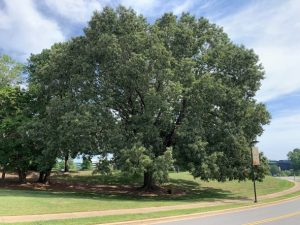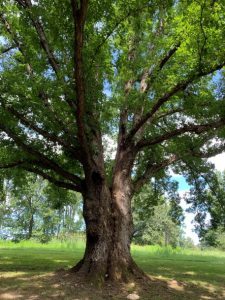Trees have been a source of awe my entire life. My grandparent’s house was an easy walk through the forest. I loved long visits with them and regularly enjoyed my grandmother’s famous chocolate chip cookies 😊. So, of course, I walked amongst the trees daily. My love for the hiking rekindled my interest in trees as an adult.

It’s hard not to notice trees when driving to work at Cary, NC headquarters (HQ). The campus is sprinkled with several majestic trees and all of them are well-nurtured by our horticulture and landscaping experts. After consulting SAS tree authorities on campus, I learned that one of my favorite trees is estimated to be over 200 years old (pictured left). It’s a HUGE Red Oak tree that I call Big Red, and the trunk is over 21 feet in circumference! Just to put this in perspective, some of the oldest trees in the world have trunk circumferences between 40 and 45 feet. Suffice it to say, several of the trees at HQ have been here much longer than I have been alive. Another Red Oak tree, which I fondly refer to as the Fertility Goddess, is over 100 years old (pictured below right). The wisdom she holds runs deep into the earth.
 As I remember from elementary school, we need trees and plants to survive. They need living beings that release carbon dioxide like us. Since breath is our first and last movement, trees play an important role in our entire lives. This relationship humbles me. But enough about how humans and trees need one another. What about trees needing one another?
As I remember from elementary school, we need trees and plants to survive. They need living beings that release carbon dioxide like us. Since breath is our first and last movement, trees play an important role in our entire lives. This relationship humbles me. But enough about how humans and trees need one another. What about trees needing one another?
Forests have a lot to teach us about life. Trees talk to one another through a fungi network which is often referred to as the wood wide web. Mycorrhiza fungi, the technical term, is a fungus root – picking up water and nutrients and trading them for photosynthetic carbon. This mutually beneficial relationship allows trees from one area of the forest to provide nutrients for another area in the forest if the needs are great. Peter Wohlleben’s book, The Hidden Life of Trees, highlights several aspects the social nature of trees and describes in much detail how trees communicate with one another. The well-being of one tree, and even one tree species directly connects the livelihood and survival of other trees. Wohlleben describes a type of social security system where the stronger trees support the weaker trees because they all have something different to offer the forest.
In a culture that often rewards competition and individual achievement over community and collective good, it makes sense for us to think that trees independently compete for resources and the most dominant survive. They do compete in some ways, and they also collaborate.
What if we took our cues from the forests?
I’ll leave you with advice from a tree by Ilan Shamir.
Stand tall and Proud
Sink your roots deeply into the Earth
Reflect the light of a greater source
Think long term
Go out on a limb
Remember your place among all living beings
Embrace with joy the changing seasons
For each yields its own abundance…
The Energy and Birth of Spring
The Growth and Contentment of Summer
The Wisdom to let go of leaves in the Fall
The Rest and Quiet Renewal of Winter
Feel the wind and the sun
And delight in their presence
Look up at the moon that shines down upon you
And the mystery of the stars at night.
Seek nourishment from the good things in life
Simple pleasures
Earth, fresh air, light
Be content with your natural beauty
Drink plenty of water
Let your limbs sway and dance in the breezes
Be flexible
Remember your roots
Enjoy the view!

3 Comments
Wood wide web...love it!!! Great blog, Rebecca! I agree that there is something magical about a walk in the woods.
Enjoyed reading and learned from it!
Thank You Rebecca!
This is so fascinating! Thank you for this reminder to love our Mother Earth and all of the living entities she supports.